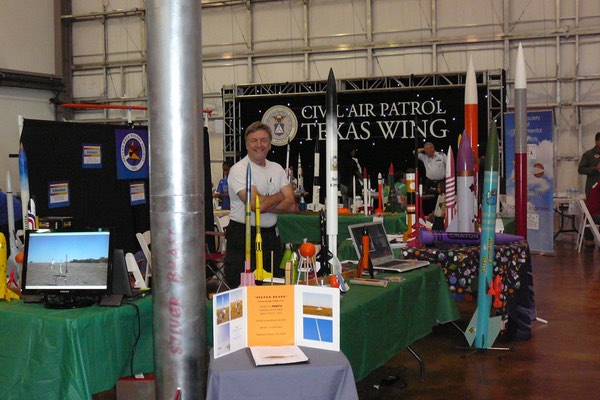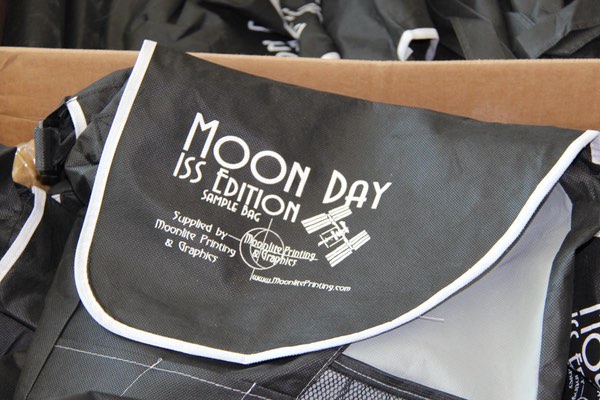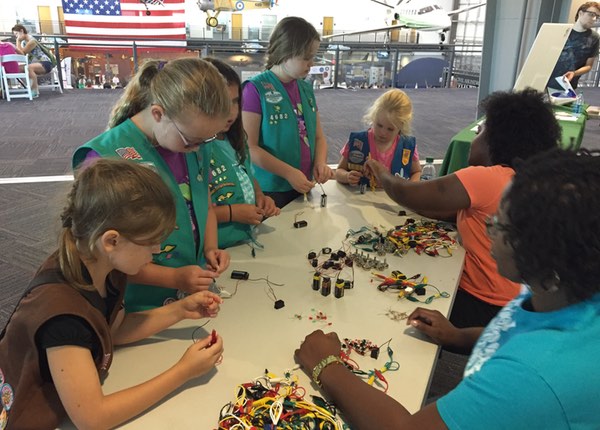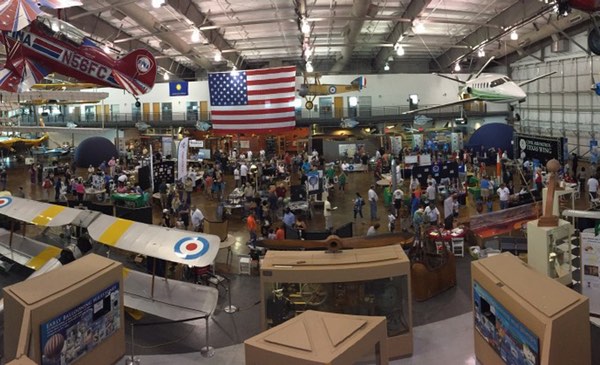Making Moon Day memorableby Ken Murphy
|
| Space advocates often bemoan the fact that space folks spend more time talking to each other than to the public at large, and in my experience this is entirely too true. So when I was elected chapter president of NSS of North Texas, I set the chapter on a path of much greater public engagement. |
Nevertheless, the museum didn’t forget about us, and we had a few outreach displays over the years when they had space-associated events, like a visit by space author Andrew Chaikin. The big break came in late 2008, when the director of the museum approached me about putting together an event celebrating the 40th anniversary of the Apollo 11 landing. Since I was only two years old when it happened, I’ve never had the almost religious reverence that most folks in the space industry seem to have for the Apollo program.
As someone with a strong business and finance background, however, I do have a reverence for the economic potential that space development offers the US and the world. Based on my experiences with the Space Generation Forum a decade earlier, I decided to eschew a standard Apollo retrospective, and proposed that we instead celebrate the future of space exploration and showcase the space-related resources that are available in North Texas. The past offers valuable lessons, but it’s hard to move forward when your gaze is fixed on the past. Why not use the Apollo 11 anniversary as a platform for looking into the future?
The museum considered my proposal and agreed to hold a public “Moon Day” event on Sunday, July 20, 2009: Moon Day because it commemorates the day we first set foot on the Moon, one of those brief moments when humanity transcended itself and achieved something truly unique in the human story. Using my contacts, I rounded up a handful of exhibitors like the Texas Astronomical Society of Dallas (TAS), Dallas Area Rocket Society (DARS), and Astronaut Training Center. I also reached out to space-related institutions across the country and requested informational literature to distribute. Additionally, I arranged for several classes and lectures on a variety of space topics.
That first year we attracted over 500 visitors, on a day where the museum might normally see only 50 to 100. Everyone was so pleased with the results that we decided to try again the next year, also on a Sunday. As with most sophomore efforts, it was more difficult with less impressive results. Attendance dipped below 500, and the future of Moon Day was looking in doubt as the museum postponed a decision on a third effort in 2011. The exhibitors all expressed an interest in doing it again, but also all recommended a move to a Saturday event despite the much longer hours involved. Eventually the museum conceded to both desires.
The switch to a Saturday proved pivotal, and attendance more than doubled to over 1,000 visitors, more than were at the International Space Development Conference I organized in 2007. There were more than a dozen exhibitors, including the TCU Monnig Meteorite Gallery in Fort Worth and Dallas Personal Robotics Group (DPRG). We got an inflatable planetarium. The Lunar Sample Bag swag bags I had instituted the year before proved increasingly popular, with over 200 distributed in about two hours. The number of classes and lectures was also growing, although attendance remained problematic and I needed to rework my strategy in that regard.
It is the three main axes of Moon Day—exhibitors, lectures, and informational materials—that has provided the framework ever since for planning efforts on my part.
 One of the many Moon Day exhibitors. (credit: K. Murphy) |
Axis 1: Exhibitors
Our exhibitors are key. One intent of Moon Day is to show off local space-related resources in North Texas. Educators can’t tap those resources if they don’t know about them. While my personal goal each year for the number of exhibitors had never been achieved, the number of exhibitors has nevertheless grown every single year since the beginning, and stood at over three dozen for 2015, the first year I have, in fact, reached my goal.
| The content quickly sorted into two main areas: the family-friendly all-ages class in our Moon Academy program, and then the more adult-level presentations in the Lunar University. (I originally pushed for Moon University, but the museum felt that Moon U is too easily misinterpreted.) |
The exhibitors break down into three general areas: not-for-profits, academic institutions, and companies. The not-for-profits are the people who are passionate about some space-related area of interest and who are happy to share their area of interest with curious souls. As the event has taken on more of a STEM-related focus, the pool of exhibitors has grown to encompass organizations like the Dallas and Fort Worth chapters of the Society of Women Engineers (SWE) and National Society of Black Engineers (NSBE). It took some work, but I even managed to convince the Dallas Mars Society (DMS) to come out for Moon Day.
Academic institutions include not only local universities, but also museums, and we’re well represented in both regards. On the academic side we have a presence from most all of the local universities: the UT Arlington Planetarium, TCU’s Monnig Meteorite Gallery, UNT’s Astronomy Outreach, the TAMU-Commerce Society of Physics Students, and Brookhaven College’s Geotechnical Institute. On the museum side, that’s where we get our inflatable planetariums—two or three per year—that are very popular.
Then there are the companies. This includes big ones like Lockheed Martin and Texas Instruments, but also small ones like Mathnasium @ Coit/Campbell who provide math content and The Color Shack Art Studio, which covers space art.
The challenge at this point is to get more of the space companies in Texas to come out. Exos Aerospace has expressed at least some interest in showing off some hardware in 2016. I’d also like to get Firefly Space Systems to come up from Austin.
It’s worth noting that we do not charge our exhibitors to show off at Moon Day. While this leaves me with no budget to work with, it also allows for everyone to participate, while recognizing that many of them are incurring costs as a part of their participation.
Axis 2: Lectures
One of the goals I have for Moon Day is to create a better-educated populace in North Texas regarding space activities. Cool exhibits are fun, but so too is learning, and so I’ve worked to arrange a full slate of speakers for each year’s event. While the organization of them was a bit haphazard at first, the content quickly sorted into two main areas: the family-friendly all-ages class in our Moon Academy program, and then the more adult-level presentations in the Lunar University. (I originally pushed for Moon University, but the museum felt that Moon U is too easily misinterpreted.)
The Moon Academy is where we cover the basics. Telescopes 101 and Constellations 101 classes are offered by the local astronomy clubs, as well as this year’s Dark Skies 101 class. Our Moon Rock Disks class run by Brookhaven College is a perennial favorite, where kids get the opportunity to hold real Moon rocks sent up from NASA’s Johnson Space Center. We also often get classes from local NASA Solar System Ambassadors.
At Lunar University, local subject matter experts have the opportunity to share their knowledge with the general public. Our longest running speaker is Dr. James Carter of UT Dallas, who discusses the JSC-1a regolith simulant he had a hand in developing, and the roles it was developed to serve. The Moon Rock Disks are back for a more advanced class that goes deeper into the mineralogy and origins of the samples. DMS presents their vision for the settlement of Mars. NSS of North Texas offers overviews of launch vehicles and NASA missions. I’ve exercised organizer’s prerogative and slotted myself for the last talk of the day, on Cislunar Space.
To try to give the Lunar University more of a scholastic veneer, I divided the content into a Pan-Solar Space Colloquium and a Cislunar Space Colloquium. So everything farther out in the solar system—asteroids, Mars, and so on—goes in the Pan-Solar Colloquium, while everything close by, like the space station overview and the various Moon-oriented presentations, are in the Cislunar Space Colloquium.
The main issue for the Lunar University is finding enough adults interested enough to turn out on a blazing hot Texas summer afternoon, and the fact that the foot traffic at Moon Day starts dropping off significantly at about 3 pm. In that regard, my exercise of executive privilege might have been an empty one, with no one around at 4 pm to hear my talk. The classes and lectures also offer a way to draw in new exhibitors. This year the local Boeing office came out to give a Mars lecture. They were so impressed with the event that they absolutely want to have a display next year. Prodea wants to completely redo their exhibit and bring in some Maker folks.
 The Moon Day “Lunar Sample Bag”. (credit: K. Murphy) |
Axis 3: Lunar Sample Bags
Who doesn’t love conference swag? The enormously popular Lunar Sample Bag swag bags were the result of one of my earliest failures. While I had arranged for a wide variety of materials to be available at the event, people were grabbing so much of them that their arms were full, and they kept dropping the stuff. The museum adapted on the fly and offered kitchen garbage bags from the volunteer room to the visitors, but I was horrified at the sight of families dragging white trash bags around the museum with all of their loot inside.
| Two hundred bags may sound like a lot, but is woefully inadequate. There are many disappointed kids once they’re gone. |
I determined to do something about it. The name Lunar Sample Bag seemed thematically appropriate, but the museum balked. People are going to expect an actual lunar sample, they insisted. (Rightly so, perhaps, as there have been inquiries.) However I decided to force the issue and underwrite the bags myself the first year. A couple of years ago, I found a local printer, Moonlite Printing & Graphics, which has graciously donated the bags ever since.
While I had ambitions of hundreds and hundreds of Lunar Sample Bags being handed out to the youth of North Texas each year, implementation of that goal was frustrated by the materials suppliers. While a few folks can handle sending 500 informational brochures, most can’t. I also quickly learned that while I might have 250 items for the bags, the volunteers stuffing the bags start running out of steam and slowing down closer to 200 bags, and we typically only get about 220 or so bags stuffed at best.
The stuffing process is amazing, with some 75 feet of table length stacked with brochures, fliers, magazines, lithos, books, pencils, buttons, rulers, bookmarks, stickers, and much more. It’s not a terribly fun process, which is why the volunteers get to be the ones handing out the bags to the happy kids. This past year was a record, with all of them gone in 30 minutes. The pre-opening line to get the bags was around the side of the museum.
Two hundred bags may sound like a lot, but is woefully inadequate. There are many disappointed kids once they’re gone. We have no metrics for tracking them after they’re handed out, but we get many anecdotal stories each year of kids pouring out the bags onto their bed or floor and spending hours, if not days, poring over the contents, even revisiting them months later. I try to make sure that all of the materials have web addresses on them so that the kids can follow up on areas of interest. If you’re interested in having your space-related informational content distributed at Moon Day, just drop us a line.
Other features
That’s the core of Moon Day, but as the event has grown it has come to include much more. This year we seized an opportunity to have a live Amateur Radio ISS (ARISS) Uplink with the International Space Station. After confirmation that we would probably get one, we solicited questions from students 18 and under over the web, and chose the top 14 based on merit. One even flew in from California to ask his question. The signal with ISS commander Gennady Padalka faded out before several of the youngsters could ask their questions, but local ISS visitor Anousheh Ansari was on hand to graciously answer all of the remaining questions before giving her own presentation on her ISS experiences.
The event was standing room only, and the biggest complaint was from folks who had travelled a long ways to see it and couldn’t get in; like space, everything at Moon Day is first-come, first-served. I also made sure that each questioner went home with a copy of SpaceStationSim (see “Review: SpaceStationSim”, The Space Review, March 27, 2006). We’ve just received word that we’ve been approved for another uplink in 2016, so now the scramble begins for other ISS-related content to complement the uplink.
Also in the auditorium was a screening of Postcards from the Future with a question-and-answer session with the director, as well as a lecture on the origins of the solar system by an SSA. We often have a space art show that I put together from the Lunar Library, but not in 2015. The museum has its own collection of space artifacts, from the Apollo 7 capsule to a Beal Aerospace nozzle, and even Walt Cunningham’s genuine Moon rock on display in their Moonwalk exhibit.
Building on our poorly-attended teacher workshop last year, I expanded to two teacher workshops in 2015: one on the ISS, the other a Lunar Sample Disk Certification course. This is an effort to encourage teachers to use more space stuff in their curriculum. We did get a bit better attendance this year, but still not as much as I had hoped.
The most interesting development has been regarding the Girl and Boy Scouts. A number of years ago, the national Girl Scouts re-did all of their patches and badges, doing away with things like Aerospace to have Science of Style and Science of Happiness badges. In response, the local council developed their own STEM program for their girls. I invited them to display this program at Moon Day, with the goal of encouraging girls to consider scouting as an activity, and they decided to take a chance. They were so impressed with the event that they asked us to do a special patch for their STEM program, as Texas Instruments had done. I scoured the various activities at Moon Day, and developed a workbook of about a dozen activity worksheets, of which they had to do five to get the special patch. While some exhibitors complained the worksheets were too tough, the Girl Scouts themselves were telling me it was too easy.
What was the best received new feature of Moon Day in 2015? The presence of a food truck. In years past, when folks left to go find lunch, they often wouldn’t come back, leaving the late afternoon a deserted wasteland.
 Girl Scouts participating in Moon Day activities. (credit: K. Murphy) |
Failures
Any undertaking of this kind of scope will be laced with failures, and my efforts have been no different.
Corporate efforts continue to be a significant problem. Not just in the underwriting department, where we have yet to find anyone in North Texas willing to throw some money at Moon Day, but also in getting space hardware to show off. Armadillo Aerospace came out once in the early years and showed off some motors, but otherwise I’ve been fruitlessly begging companies like SpaceX to please come show off some space hardware for the North Texas community.
| Each year I contact JSC public affairs for Lunar Sample Bag materials, and they send me a link to a webpage. They explain that they’ve had budget cuts and so don’t have physical EPO materials or whatever. It’s actually the kids who are doing without. |
My desire for such is driven by larger economic concerns. I recognize how important the space industry can be in the future, and I want my state to have an important role in that future. The space industry is currently in a state somewhat akin to that of aviation in the early days of the Age of Airshows. Folks have heard about this space thing, but it remains something well removed from quotidian concerns. It took the aviation industry going around the country before there was widespread acceptance of the industry and its potential.
So too is the case now for the space industry. Industry folks show off for other industry folks in the pursuit of a small pool of mostly government contracts. Growing the industry requires industry participants taking the time to educate the broader citizenry about the value of space activities. That’s what helps to bring new ideas to market.
Another significant failure on my part is getting NASA involved in some way. I do get a variety of NASA materials from different areas of the organization, like Spinoff-related materials and Tech Briefs from Tech Transfer, or “meatball” NASA stickers. However, my dealings with NASA/JSC have been uniformly frustrating. Each year I contact JSC public affairs for Lunar Sample Bag materials, and they send me a link to a webpage. They explain that they’ve had budget cuts and so don’t have physical EPO materials or whatever.
Remember, the kids are poring over the materials in the bags. They love them. You won’t find a more targeted market audience. I just can’t seem to get Houston to recognize that, and it’s actually the kids who are doing without.
So with the ARISS uplink, I figured hey, why don’t I contact the ISS Program Office directly to see if they might have anything? Unfortunately, they offered no materials. I did end up with some materials from other organizations, but nothing from NASA.
Getting astronauts to come out for Moon Day has also been a struggle. After years of cajoling, local astronaut Anousheh Ansari came out to support the ISS uplink. I’ve also been asking Richard Garriott to come up from Austin for the event, so that my first two astronauts at Moon Day will have been folks who paid their own way into space. There are former NASA astronauts in the area, just none at Moon Day. The museum director assures me that they’re working that angle.
Not being able to find an underwriter has also been a failure, though not entirely of my own making. The museum has enjoined me from soliciting funds for Moon Day so as not to step on their toes during their fundraising efforts or confuse donors. And most folks that they talk to just don’t understand what Moon Day is all about. It really is something you have to experience to really get it, but once you do you’re hooked. It’s why people come back.
The major failure in 2015 was the teacher workshops. The location chosen was a small amphitheatre at the far end of the museum, far removed from the main activities. Both presenters were most unhappy with the experience. This was the end result of my not adequately marketing the workshops to local teachers earlier in the year.
Some schemes require longer to come to fruition than others. For many years I’ve wanted to do a Moonbounce at Moon Day. Not the bounce house, but bouncing a signal off of the Moon and seeing what comes back. Our local AMSAT/ARRL folks have that on their agenda, possibly as part of a larger national or global effort, but we need the right geometry for it to happen.
Conclusion
In spite of those problems, Moon Day is an enormously successful event each year. Attendance keeps climbing (1,600 in 2015, short of my 2,000 goal), more exhibitors come on board each year, media coverage is slowly increasing, and the engagement on the part of the hundreds and hundreds of kids is palpable. As the late museum founder Jan Colmer noted at his last Moon Day, “Golly, I have never seen so many people in my museum before!” Our Girl Scout contact noted that Moon Day is head and shoulders above every other STEM event they’ve seen in the area, except maybe Sally Ride Science, which does send materials for the swag bags.
| If people are going to celebrate space activities, it won’t be because the government dictates a particular day to do so, but rather because that’s when people get together to celebrate some aspect of their culture. |
The Lunar Sample Bags go faster and faster each year as the pre-opening line gets longer and longer. Girl Scouts come down from Oklahoma City, a four-hour drive, to attend. We’ve had visitors from as far away as New York, California, Montana, and Mexico. The museum is happy with what has become their single biggest attendance day each year, as well as the traffic through their gift shop. There’s no gauge by which Moon Day is not a success each and every year.
Holidays are something that people celebrate, not something that governments mandate. If people are going to celebrate space activities, it won’t be because the government dictates a particular day to do so, but rather because that’s when people get together to celebrate some aspect of their culture. The first steps on the Moon are a human cultural achievement, and so the idea of celebrating space activities on or near that anniversary is a compelling one, serving to imbue real space activities into a broader cultural milieu besotted with space fantasy. It’s also why there are more and more Moon Day events happening each year around the country, and the world. It’s something that space advocates can easily cultivate in their own communities if they’re so inclined. Reflecting on the thousands of young lives that I’ve impacted through this project, I can assure you that the value of doing so is enormous, and the rewards are incalculable.
